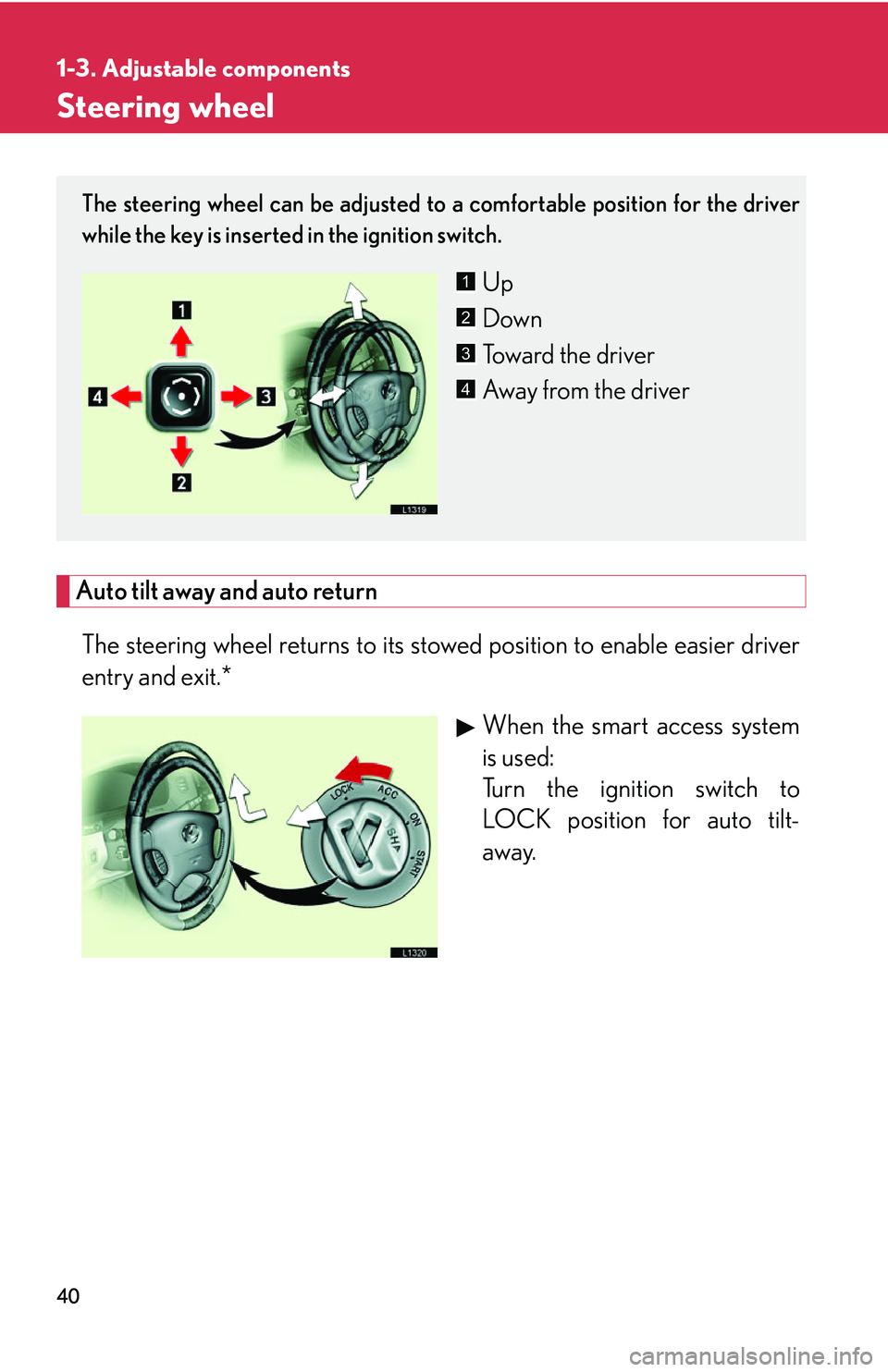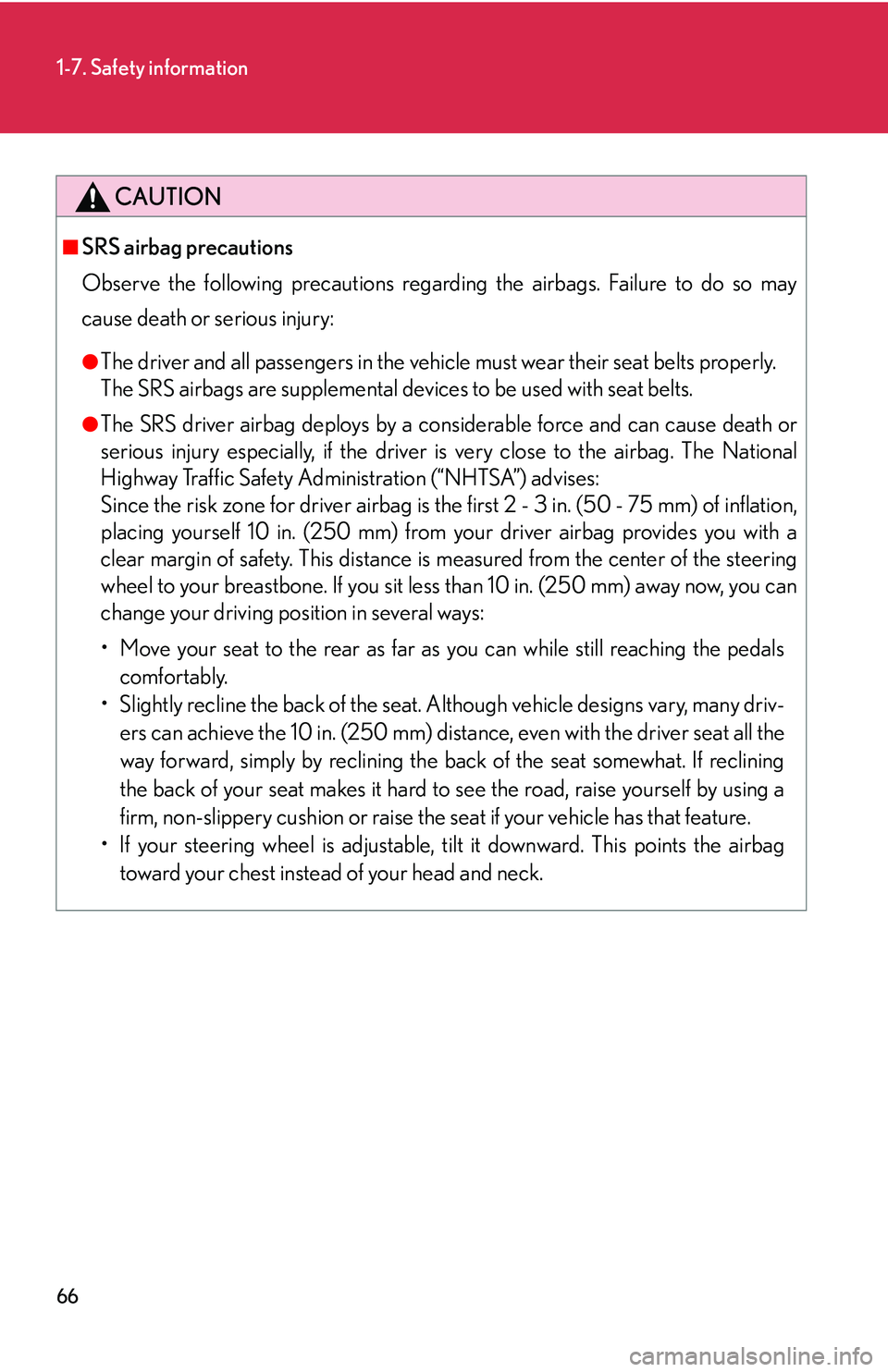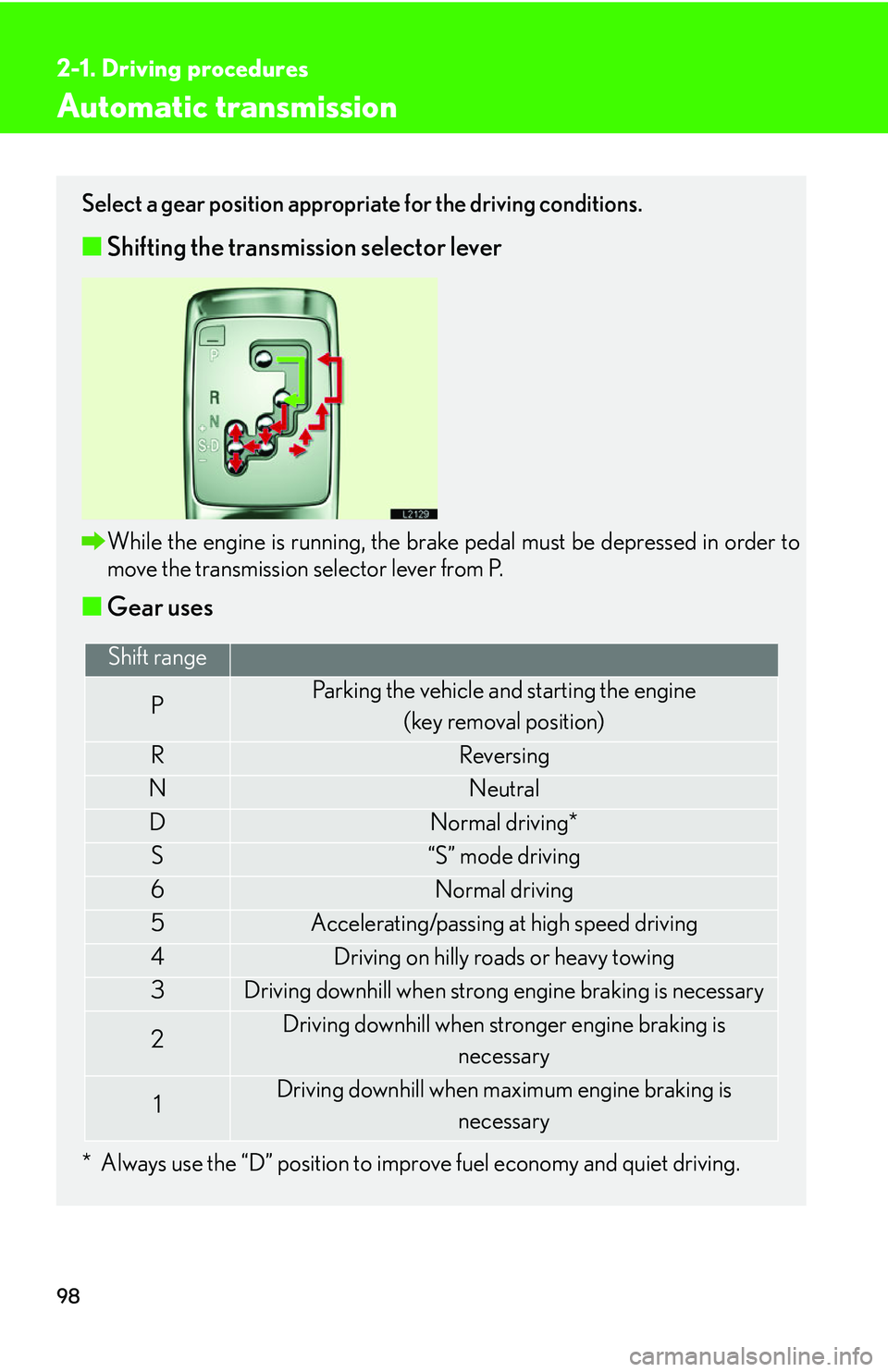2006 LEXUS LS430 tow
[x] Cancel search: towPage 1 of 419

TABLE OF CONTENTS
1Before drivingAdjusting and operating features such as door locks, mir-
rors, and steering column.
2When drivingDriving, stopping and safe-driving information.
3Interior featuresAir conditioning and audio systems, as well as other
interior features for a comfortable driving experience.
4Maintenance
and careCleaning and protecting your vehicle, performing do-it-
yourself maintenance, and maintenance information.
5When trouble
arisesWhat to do if the vehicle needs to be towed, gets a flat tire,
or is involved in an accident.
6Vehicle
specificationsDetailed vehicle information.
7For US ownersReporting safety defects for US owners
IndexAlphabetical listing of information contained in this
manual.
Page 3 of 419

1
2
3
4
5
6
7
2-3. Operating the headlight and windshield wipers ..................... 110
Headlight switch ............................. 110
Fog light switch ................................ 113
Windshield wipers and
washer............................................... 114
Headlight cleaner switch ............. 117
2-4. Using other driving systems..... 118 Lexus park assist system ............. 118
Rear view monitor system ......... 123
Cruise control ................................ 126
Dynamic radar/ laser cruise
control............................................. 129
Electronically modulated air
suspension..................................... 138
Driver assist systems.................... 140
Pre-collision system
(if equipped) ................................. 143
2-5. Driving information ................... 145 Cargo & luggage .......................... 145
Vehicle load limits ......................... 148
Winter driving tips ........................ 149
Trailer Towing................................. 152
Dinghy towing ................................ 160
3-1. Using the air conditioning
system and defogger .............. 162 Automatic air conditioning
control............................................. 162
Rear window defogger ............... 170
Rear air conditioning controls .. 172
3-2. Using the audio system............. 174 Audio system ................................... 174
Operating the radio ...................... 176
Operating the cassette player............................................... 182
Using the CD changer ............... 185
Optimal use of the audio
system ............................................... 191
Using the rear controller ........... 193
Using the steering switches ...... 195
3-3. Turning on interior lights......... 198 Interior lights list............................. 198
3-4. Storage......................................... 201 Storage features ............................ 201
3-5. Other interior features .......... 208 Sun visors........................................ 208
Vanity mirror and light ............... 209
Clock.................................................. 210
Ashtray ................................................ 211
Cigarette li ghter
............................ 213
Power outlets .................................. 214
Outside temperature display ... 216
Seat heaters..................................... 218
Climate control seat
switches ......................................... 220
3Interior features
Page 4 of 419

TABLE OF CONTENTSIndex
Refreshing rear seat
switches ......................................... 222
Coat hooks ..................................... 223
Floor mats........................................ 224
Sunshades ....................................... 225
Trunk features................................ 227
Garage door opener .................. 232
Compass (vehicles without
navigation syst em)
................... 238
4-1. Maintenance and care............ 244 Cleaning and protecting the
vehicle exterior .......................... 244
Cleaning and protecting the
vehicle interior............................ 247
4-2. Maintenance ............................. 250 Maintenance requ irements
.... 250
General maintenance ................ 252
Emission inspection and
maintenance (I/M)
programs....................................... 255
4-3. Do-it-yourself
maintenance ........................... 256
Do-it-yourself service
precautions .................................. 256
Hood................................................. 260
Positioning the jack ...................... 261
Engine compartment.................. 262 Tires ................................................... 278
Tire inflation pressure................ 283
Wheels.............................................. 287
Air conditioning filters............... 289
Wireless remote control
battery ............................................ 295
Blade fuses ..................................... 298
Cartridge fuses ............................ 309
Headlight aim.................................... 311
Light bulbs ........................................ 313
5-1. Essential information .............. 320 If your vehicle needs to be
towed............................................. 320
If you think something is
wrong ............................................. 324
Fuel pump shut off system ........ 325
Event data recorder .................... 326
5-2. Steps to take in an
emergency .............................. 328
If a warning light turns on... ...... 328
If a warning message
appears.......................................... 334
If you have a flat tire..................... 347
If the engine will not start ......... 353
If the transmission selector
lever cannot be shifted
from P............................................. 354
If you lose your keys ................... 355
4Maintenance and care
5When trouble arises
Page 24 of 419

8
1-2. Opening, closing and locking the doors and trunk
■To secure the system operation
In the following cases, the smart access system or wireless remote control feature
ma
y not operate properly. (If this happens, use a mechanical key to lock or unlock
the doors and trunk lid and insert a master key to start the engine.)
• When facilities emitting strong elec tr
omagnetic waves such as TV towers,
electric power stations and broadcasting stations are nearby.
• When you are carrying a smart key together with a mobile communications sy
stem such as a two-way radio or cellular phone.
• When the smart key is in contact with or covered by a metallic object.
• When another person is operating a wi r
eless remote control function on
another vehicle near your vehicle.
If you do not drive your vehicle, store the smart key, keeping it at least 15 ft. (5 m)
a
way from the vehicle.
■If the key battery is discharged
Use the mechanical key to lock or unlock doors or trunk lid. To start the engine,
inse
rt the master key in the ignition switch. See page 295 for replacing the key bat -
tery.
Page 56 of 419

40
1-3. Adjustable components
Steering wheel
Auto tilt away and auto return
The steering wheel returns to its stowed position to enable easier driver
entry and exit.*When the smart access system
is used:
Turn the ignition switch to
L
OCK position for auto tilt-
away.
The steering wheel can be adjusted to a comfortable position for the driver
while the key is inserted in the ignition switch.
Up
Down
Toward the driver
Away from the driver1
2
3
4
Page 82 of 419

66
1-7. Safety information
CAUTION
■SRS airbag precautions
Observe the following precautions regarding the airbags. Failure to do so may
ca
use death or serious injury:
●The driver and all passengers in the vehicle must wear their seat belts properly.
The SRS airbags are supplemental devices to be used with seat belts.
●The SRS driver airbag deploys by a cons iderable force and can cause death or
serious injury especially, if the driver is very close to the airbag. The National
Highway Traffic Safety Administration (“NHTSA”) advises:
Since the risk zone for driver airbag is th e fi
rst 2 - 3 in. (50 - 75 mm) of inflation,
placing yourself 10 in. (250 mm) from your driver airbag provides you with a
clear margin of safety. This distance is measured from the center of the steering
wheel to your breastbone. If you sit less than 10 in. (250 mm) away now, you can
change your driving position in several ways:
• Move your seat to the rear as far as you can while still reaching the pedals
co
mfortably.
• Slightly recline the back of the seat. Alt
hough vehicle designs vary, many driv-
ers can achieve the 10 in. (250 mm) distance, even with the driver seat all the
w
ay forward, simply by reclining the back of the seat somewhat. If reclining
the back of your seat makes it hard to see the road, raise yourself by using a
firm, non-slippery cushion or raise the seat if your vehicle has that feature.
• If your steering wheel is adjustable, ti lt it do
wnward. This points the airbag
toward your chest instead of your head and neck.
Page 101 of 419

2When driving
85
2-1. Driving procedures ................. 86Driving the vehicle ...................... 86
Starting the engine ...................... 94
Automatic transmission ............ 98
Turn signal lever ............................ 101
Parking brake .............................. 102
2-2. Instrument cluster .................. 103 Gauges and meters .................. 103
Indicators and warning
lights ............................................. 105
Multi-information display ........ 107
2-3. Operating the headlight and
windshield wipers .................. 110
Headlight switch .......................... 110
Fog light switch ............................. 113
Windshield wipers and
washer ........................................... 114
Headlight cleaner switch.......... 117 2-4. Using other driving
systems ..................................... 118
Lexus park assist system ........... 118
Rear view monitor system....... 123
Cruise control .............................. 126
Dynamic radar/ laser cruise
control .......................................... 129
Electronically modulated air
suspension.................................. 138
Driver assist systems ................. 140
Pre-collision system
(if equipped) .............................. 143
2-5. Driving information ................ 145 Cargo & luggage ....................... 145
Vehicle load limits....................... 148
Winter driving tips...................... 149
Trailer Towing ............................... 152
Dinghy towing.............................. 160
Page 114 of 419

98
2-1. Driving procedures
Automatic transmission
Select a gear position appropriate for the driving conditions.
■Shifting the transmission selector lever
While the engine is running, the brake pedal must be depressed in order to
move the transmission selector lever from P.
■Gear uses
* Always use the “D” position to improve fuel economy and quiet driving.
Shift range
PParking the vehicle and starting the engine
(key removal position)
RReversing
NNeutral
DNormal driving*
S“S” mode driving
6Normal driving
5Accelerating/passing at high speed driving
4Driving on hilly roads or heavy towing
3Driving downhill when strong engine braking is necessary
2Driving downhill when stronger engine braking is necessary
1Driving downhill when maximum engine braking is
necessary